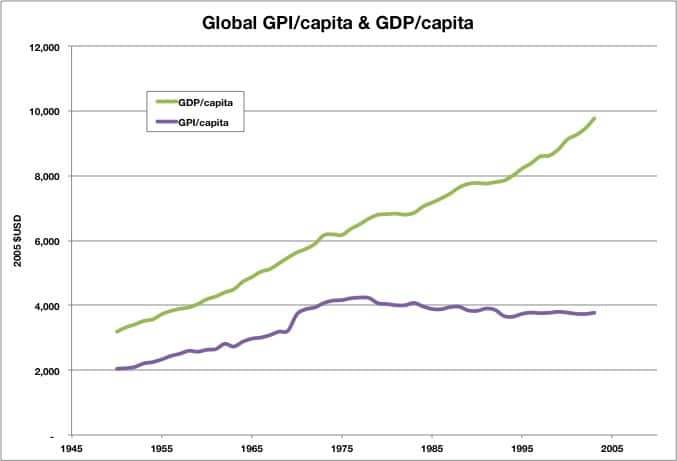The Genuine Progress Indicator (GPI) is an attempt to measure the real increase in economic welfare.
The GPI measures the improvement in economic welfare – costs associated with growth. It is measured using the formula
GPI = A + B – C – D + I
- A is income weighted private consumption
- B is value of non-market services generating welfare
- C is private defensive cost of natural deterioration
- D is cost of deterioration of nature and natural resources
- I is an increase in capital stock and balance of international trade
The GPI takes a wider measure of economic indicators into consideration. For example, GPI includes
- value of voluntary work and unpaid work.
- value of leisure time
- Distribution of income
- Impact on the environment
- Environmental standards
- Cost of crime
See list at the bottom for more details.
Advantages of Using GPI
- GDP doesn’t take into account negative externalities of growth. Higher GDP may lead to a large rise in pollution, crime and congestion leaving people with lower economic welfare and lower levels of happiness. Therefore, GDP can be misleading as an account of economic welfare.
- By focusing on a wider measure of economic indicators, it encourages policymakers to think in broader terms of economic welfare and not just crude GDP statistics.
- GDP only measures output – not how it actually affects people’s living standards and how it is used in society.
- Encourages long-term planning. i.e. sustainable growth rather than short-term measures which increase GDP at expense of damaging the environment.
Disadvantages of Using GPI
- Many non-economic variables such as the value of leisure time/environment are very subjective and it can be difficult to assign an economic value. GDP is simpler and gives less normative results.
- Not useful for judging the state of the business cycle.
Conclusion
Rather than GDP v GPI, it is useful to use both and see them as complementary indexes. GDP will always have a use for economic accounting. However, it clearly has limitations. Using an additional measure such as GPI helps to give a better understanding of real economic development.
What is included in GPI?

Nova Scotia GPI Components
Time Use
• Value of Civic and Voluntary Work
• Value of Unpaid Housework and Child Care
• Value of Leisure Time
• Paid Work Hours
Living Standards
• Income and its Distribution
• Financial Security – Debt and Assets
• Economic Security Index
Natural Capital
• Soils & Agriculture
• Forests
• Fisheries and Marine Resources
• Energy
• Air
• Water
Human Impact on the Environment
• Solid Waste
• Ecological Footprint
• Greenhouse Gas Emissions
• Transportation
Human and Social Capital
• Population Health
• Costs of Crime
• Educational Attainment
Source: GPI
Related

Where can I find access to a database of broad GPI metrics for varies countries similar to how FRED has robust data for GDP?
At the bottom of this page:
https://dnr.maryland.gov/mdgpi/Pages/overview.aspx
As the population we must focus on Genuine progress indicator inseated of focus on Gross Domestic Product
Because GPI Is essential to to community and the first is welfaire of people